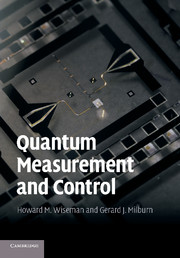Book contents
- Frontmatter
- Contents
- Preface
- 1 Quantum measurement theory
- 2 Quantum parameter estimation
- 3 Open quantum systems
- 4 Quantum trajectories
- 5 Quantum feedback control
- 6 State-based quantum feedback control
- 7 Applications to quantum information processing
- Appendix A Quantum mechanics and phase-space
- Appendix B Stochastic differential equations
- References
- Index
5 - Quantum feedback control
Published online by Cambridge University Press: 17 February 2011
- Frontmatter
- Contents
- Preface
- 1 Quantum measurement theory
- 2 Quantum parameter estimation
- 3 Open quantum systems
- 4 Quantum trajectories
- 5 Quantum feedback control
- 6 State-based quantum feedback control
- 7 Applications to quantum information processing
- Appendix A Quantum mechanics and phase-space
- Appendix B Stochastic differential equations
- References
- Index
Summary
Introduction
In the preceding chapter we introduced quantum trajectories: the evolution of the state of a quantum system conditioned on monitoring its outputs. As discussed in the preface, one of the chief motivations for modelling such evolution is for quantum feedback control. Quantum feedback control can be broadly defined as follows. Consider a detector continuously producing an output, which we will call a current. Feedback is any process whereby a physical mechanism makes the statistics of the present current at a later time depend upon the current at earlier times. Feedback control is feedback that has been engineered for a particular purpose, typically to improve the operation of some device. Quantum feedback control is feedback control that requires some knowledge of quantum mechanics to model. That is, there is some part of the feedback loop that must be treated (at some level of sophistication) as a quantum system. There is no implication that the whole apparatus must be treated quantum mechanically.
The structure of this chapter is as follows. The first quantum feedback experiments (or at least the first experiments specifically identified as such) were done in the mid 1980s by two groups [WJ85a, MY86]. They showed that the photon statistics of a beam of light could be altered by feedback. In Section 5.2 we review such phenomena and give a theoretical description using linearized operator equations. Section 5.3 considers the changes that arise when one allows the measurement to involve nonlinear optical processes.
- Type
- Chapter
- Information
- Quantum Measurement and Control , pp. 216 - 268Publisher: Cambridge University PressPrint publication year: 2009
- 1
- Cited by



